1.a. Orthognathous chelicerae: basal segments parallel forwards, fangs almost parallel; gnathocoxa with long projection; four booklung covers ... Atypidae

Key to families
adapted from "Spinnen
Mitteleuropas"
1.a. Orthognathous
chelicerae: basal segments parallel forwards, fangs almost parallel; gnathocoxa
with long projection; four booklung covers ... Atypidae

1.b. Labidognathous
chelicerae: basic segments pointing downwards, tips of fangs directed toward
each other ... 2
2.a.
Anterior median eyes clearly larger than other eyes. Field of eyes quadrangular
in dorsal view ... Salticidae
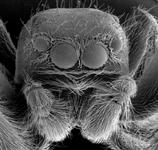
2.b. Anterior median
eyes usually not clearly larger than other eyes (if larger, then eye field
not quadrangular in dorsal view) ... 3
3.a.Only
one pair of spinnerets clearly visible (the others reduced and hardly visible),
and positioned on a bump. Anterior median eyes largest. Associated with
ants; hunting spiders ... Zodariidae
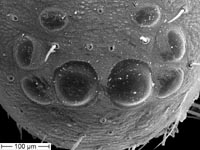
3.b.Three pairs of
spinnerets clearly visible (median spinnerets may be small and hidden by
the anterior and posterior pair of spinnerets) ... 4
4.a. Posterior
median eyes and posterior lateral eyes arranged in an equilateral hexagon
(viewed from frontally). Legs with long spines, opisthosoma tapered, habitus
as in photo; hunting spiders ... Oxyopidae
4.b. Position of eyes different ... 5
5.a.
Posterior lateral eyes larger than other eyes; male with characteristic
bundle of hairs on anterior spinnerets (photo). Prosoma with characteristic
pattern of stripes; tips of tarsi covered with scopulate hairs. Habitus
as in photo. Free living on ground ... Zoridae
5.b. Posterior lateral eyes not larger than other eyes; no bundle of hairs on male anterior spinnerets ... 6
6.a.
Eyes clearly arranged in three straight rows: anterior eyes - posterior
median eyes - posterior lateral eyes ... 7
6.b. Eyes different ... 8
7.a.
Connecting line of posterior lateral eyes - posterior median eyes intersects
middle line of carapace at anterior edge of prosoma or closely behind it.
Position of eyes as in photo. Hunting spiders; females carry egg sac in
their chelicerae ... Pisauridae
7.b. Connecting line
of posterior lateral eyes - posterior median eyes intersects middle line
of carapace in front of anterior edge of prosoma. Position of eyes as in
photo. Hunting spiders, females carry egg sac attached to spinnerets ...
Lycosidae
8.a.
Position of frontal two pairs of legs laterigrade, the original front side
directed upwards, hence "crab-like" habitus; eyes often surrounded white
... 9
8.b. Position of frontal two pairs of legs not laterigrade ... 11
9.a.
Legs I and II clearly longer and often stouter than legs III, IV. Eyes
often on elevations as shown below ... Thomisidae
9.b. Legs I and II not clearly longer and stouter than legs III, IV ... 10
10.a.
Scopula on tarsi and metatarsi ... Sparassidae
10.b. Scopula only
on tips of tarsi, habitus as in photo ... Philodromidae

11.a.
Secondary eyes (anterior lateral eyes, posterior lateral and median eyes)
arranged in two groups of three eyes each; between them a pair of
small anterior median eyes may be present or not. Legs remarkably long
and slender; in irregular webs, mostly synanthropic ... Pholcidae
11.b. Eyes different ... 12
12.a.
Haplogyne spiders: female without epigynum, male with pear-, onion- or
bottle shaped bulb. Basal, mostly thickened part of bulb scarcely covered
by cymbium. Almost always six eyes ... 13

12.b. Entelegyne spiders:
female with epigynum, male with complex bulb, with basal part largely covered
by cymbium (mostly eight eyes) ... 16
13.a.
Eyes in one group: all eyes clearly less than one eye diameter separated
from each other (exception: distance between anterior eyes and posterior
eyes can be larger, so that the eyes form a closed circle) ... 14
13.b. Eyes not in one group: eyes or groups of eyes separated by a clearly visible interspace (> diameter of eyes) ... 15
14.a.
Body length <2 mm, with massive scutum on opisthosoma and armored
pleura or faint white to reddish; eyes as in photo ... Oonopidae

14.b. Body length
>3 mm, habitus as in photo ... Dysderidae
15.a.
Body colour dark gray, black or dark brown. Prosoma not strikingly marked.
Position of legs characteristic: Legs I-III directed forwards; legs rather
strong. Eyes and habitus as in photos ... Segestriidae
15.b. Body colour
light reddish to yellowish brown, prosoma very high, eyes as in photo;
body with distinctive black pattern, position of legs normal, legs very
slender ... Scytodidae
16.a.
Tarsi of legs with 3 claws. Middle claw often very small and covered
by hairbrushes, best visible from ventrally (scopulate hairs are in this
case mostly divided into two cushions, between them the middle claw is
visible) ... 17
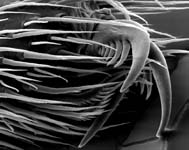
16.b. Tarsi of legs with 2 claws (without median claw) ... 35
17.a.
Lateral eyes (arrows) form a square over the total width of the prosoma.
Females - mostly with exception of the frontal head region - monochromous
black, with cribellum/calamistrum. Males with vermilion opisthosoma with
2-3 pairs of black dots. Body with velvety hairs. Females in flat cribellate
webs ending in a tube. In xerotherm areas, rare ... Eresidae
17.b. Eyes different ... 18
18.a.
Between the long posterior spinnerets a remarkable anal tubercle with star-like
brushes. Habitus as in photo ... Oecobiidae
18.b. Anal tubercle normal; posterior spinnerets short or long ... 19
19.a. Tarsus dorsally with 0-2 trichobothria ... 20
19.b. Tarsus dorsally
with at least 3 trichobothria ... 29
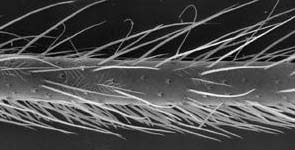
20.a.
Prosoma and habitus as in photos. Cribellate, in horizontal orb webs or
in triangular webs ...
Uloboridae
20.b. Habitus different; cribellate or ecribellate ... 21
21.a.
Spinnerets arranged in one transverse row ... Hahniidae
part. (Hahnia, Antistea)
21.b. Spinnerets different ... 22
22.a. Anterior spinnerets divided by twice their diameters, not arranged transversally. Males with a twisted embolus, long, reaching backwards till the beginning of the tibia, females correspondingly with long, irregularly declining entrance openings, +/- visible through the epigynum; very rare ... Hahniidae: Tuberta
22.b. Spinnerets different ... 23
23.a. Cribellate spiders: female with cribellum and calamistrum; male with broad rudiment of cribellum ... Dictynidae part. (excl. Cicurina, Mastigusa)
23.b. Not cribellate, in front of spinnerets a point like colulus or colulus reduced. In the last case - especially in small spiders - mostly 2 or more bristles replace colulus ... 24
24.a.
Tibia
and metatarsus I and II with one row of long spines, between them shorter
spines. Opisthosoma with at least 1 pair of humps, habitus as in photo
... Mimetidae
24.b. Tibia and metatarsus I and II normally without obvious rows of spines; when rows of spines present, then opisthosoma without humps ... 25
25.a.
Male palp with enormous, dark, proximal paracymbium (arrow). Females with
row of strong and serrated hairs ventrally on tarsus IV; labium distally
with whitish swelling as in photo ... Nesticidae
25.b. Different ... 26
26.a.
Male palp with small distal paracymbium or paracymbium lacking, tibia of
palp lying very close to the cymbium with spoon like anterior edge on ventral
side (often covers posterior area of bulb); females with rows of strong
and serrated bristles ventrally on tarsus IV (photo) or in multiple rows;
pigment of posterior eyes mostly brighter than that of the anterior median
eyes, anterior median eyes often silvery white, chelicerae mostly weak
or almost toothless ... Theridiidae
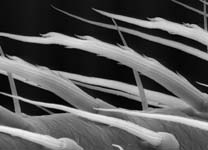
26.b. Females without row of strong bristles on tarsus IV, male palp different. Chelicerae mostly with two clearly visible rows of teeth ... 27
27.a.
Gnathocoxae at least 1.5 x longer than wide. Chelicerae often long and
diverging. Paracymbium of male palp almost always very long or large. Orb
webs with open hub ... Tetragnathidae
27.b. Gnathocoxae less than 1.5 x longer than wide ... 28
28.a.
Height of clypeus less than 2 diameters of anterior median eyes; chelicerae
without stridulatory ridges. Chelicerae mostly with lateral proximal hump
(arrow). Proximal paracymbium of male palp almost always relatively small
and glossy (cf
Tetragnathidae). Orb webs with closed hub. Often
big and strong spiders; mostly with relatively short, strongly spined legs)
... Araneidae
28.b. Clypeus normally
higher than 2 diameters of anterior median eyes; if less high (Tapinopa,
Poeciloneta), then chelicerae with lateral stridulatory ridges. Chelicerae
without lateral humps. Sheet-web spiders ... Linyphiidae
29.a. Tarsus I with 3 dorsal trichobothria ... 30
29.b. Tarsus I with at least 4 dorsal trichobothria ... 31
30.a. Anterior spinnerets separated by twice their diameter. Males with very long embolus, enclosing largely the patella; female with long, irregular insemination ducts, visible through epigynum. Myrmecophiles, extremely rare ... Dictynidae: Mastigusa
30.b. Anterior spinnerets
separated by their diameter. Embolus and insemination ducts shorter ...
Hahniidae:
Cryphoeca
31.a.
Anterior spinnerets separated by at least their diameter. Posterior spinnerets
slightly longer than anterior - distinction to Textrix, Agelenidae,
where the anterior spinnerets are separated by about their diameter, but
the posterior spinnerets are approx. twice as long as the anterior ones
... Dictynidae:
Cicurina
31.b. Anterior spinnerets separated by less than their diameter ... 32
32.a.
Posterior spinnerets clearly (about 2x) longer than anterior ones ... 33
32.b. Posterior spinnerets
about as long as or shorter than anterior ones ...
34
33.a.
Head region large and rounded off laterally, thorax region <1,5
x as large as head region, leg I roughly as long as body. Male palp with
apophysis on tibia and patella ... Amaurobiidae:
Coelotes
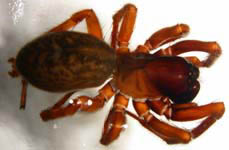
33.b. Head region
smaller, laterally almost rectangularly outlined, thorax region >1,5
x as large as head region, leg I clearly longer than body. Male palps mostly
without apophysis on patella (exception: Agelena) ... Agelenidae
34.a.
Cribellate spiders, chelicerae at the base knee-like projecting (viewed
from above). Labium at base clearly narrowed, calamistrum with two
rows, male chelicerae without short lateral spines. Habitus as in photo
... Amaurobiidae part (excl.
Coelotes)

34.b. Ecribellate
spiders, chelicerae not knee-like projecting (viewed from above) ... Cybaeidae
35.a.
Tracheal stigma in the middle between epigastric fold and spinnerets, dorsal
pattern as in photo ... Anyphaenidae
35.b. Tracheal stigma right in front of spinnerets ... 36
36.a.
Basal segments of spinnerets cylindrical and mostly long (photo). Posterior
median eyes often oval (photo), kidney shaped or angular. In the genus
Micaria
the posterior median eyes are oval, but the spinnerets are mostly short;
therefore they appear atypical. The identification marks are here the white
or metallic scaly hairs on body and legs, the ant-like habitus and a saddle-shaped
constriction of the opisthosoma which is mostly present ... Gnaphosidae
36.b. Basal segments of spinnerets rather conical ... 37
37.a.
Labium larger than long or about as long as large. Width of eye field
<½ maximum width of prosoma ... Liocranidae
(incl. Corinnidae)
37.b. Labium clearly
longer than large. Width of eye field about half the width of the prosoma,
but mostly clearly >½ maximum width of prosoma (photo) ... Clubionidae
(incl. Miturgidae)

Copyright: All images are copyrighted but may be downloaded for private use